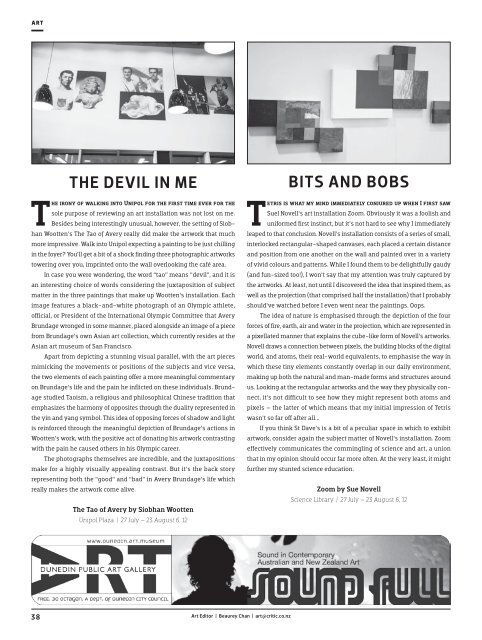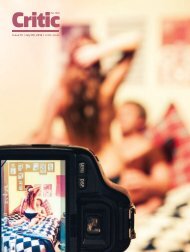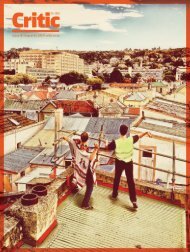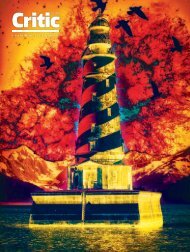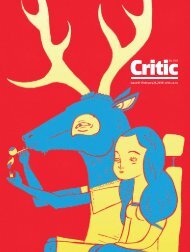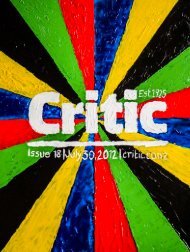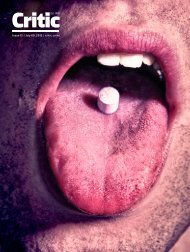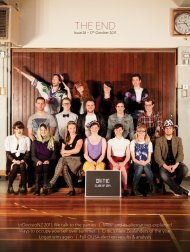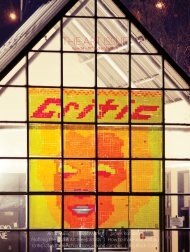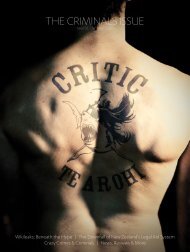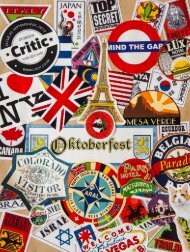Issue 20 | August 13,2012 | critic.co.nz
Issue 20 | August 13,2012 | critic.co.nz
Issue 20 | August 13,2012 | critic.co.nz
Create successful ePaper yourself
Turn your PDF publications into a flip-book with our unique Google optimized e-Paper software.
Art<br />
38<br />
THE DEvIL IN ME<br />
The irony of walking into Unipol for the first time ever for the<br />
sole purpose of reviewing an art installation was not lost on me.<br />
Besides being interestingly unusual, however, the setting of Siobhan<br />
Wootten’s The Tao of Avery really did make the artwork that much<br />
more impressive. Walk into Unipol expecting a painting to be just chilling<br />
in the foyer? You’ll get a bit of a shock finding three photographic artworks<br />
towering over you, imprinted onto the wall overlooking the café area.<br />
In case you were wondering, the word “tao” means “devil”, and it is<br />
an interesting choice of words <strong>co</strong>nsidering the juxtaposition of subject<br />
matter in the three paintings that make up Wootten’s installation. Each<br />
image features a black-and-white photograph of an Olympic athlete,<br />
official, or President of the International Olympic Committee that Avery<br />
Brundage wronged in some manner, placed alongside an image of a piece<br />
from Brundage’s own Asian art <strong>co</strong>llection, which currently resides at the<br />
Asian art museum of San Francis<strong>co</strong>.<br />
Apart from depicting a stunning visual parallel, with the art pieces<br />
mimicking the movements or positions of the subjects and vice versa,<br />
the two elements of each painting offer a more meaningful <strong>co</strong>mmentary<br />
on Brundage’s life and the pain he inflicted on these individuals. Brundage<br />
studied Taoism, a religious and philosophical Chinese tradition that<br />
emphasizes the harmony of opposites through the duality represented in<br />
the yin and yang symbol. This idea of opposing forces of shadow and light<br />
is reinforced through the meaningful depiction of Brundage’s actions in<br />
Wootten’s work, with the positive act of donating his artwork <strong>co</strong>ntrasting<br />
with the pain he caused others in his Olympic career.<br />
The photographs themselves are incredible, and the juxtapositions<br />
make for a highly visually appealing <strong>co</strong>ntrast. But it’s the back story<br />
representing both the “good” and “bad” in Avery Brundage’s life which<br />
really makes the artwork <strong>co</strong>me alive.<br />
The Tao of Avery by Siobhan Wootten<br />
Unipol Plaza | 27 July – 23 <strong>August</strong> 6, 12<br />
Art Editor | Beaurey Chan | art@<strong>critic</strong>.<strong>co</strong>.<strong>nz</strong><br />
BITS AND BOBS<br />
Tetris is what my mind immediately <strong>co</strong>njured up when I first saw<br />
Suel Novell’s art installation Zoom. Obviously it was a foolish and<br />
uniformed first instinct, but it’s not hard to see why I immediately<br />
leaped to that <strong>co</strong>nclusion. Novell’s installation <strong>co</strong>nsists of a series of small,<br />
interlocked rectangular-shaped canvases, each placed a certain distance<br />
and position from one another on the wall and painted over in a variety<br />
of vivid <strong>co</strong>lours and patterns. While I found them to be delightfully gaudy<br />
(and fun-sized too!), I won’t say that my attention was truly captured by<br />
the artworks. At least, not until I dis<strong>co</strong>vered the idea that inspired them, as<br />
well as the projection (that <strong>co</strong>mprised half the installation) that I probably<br />
should’ve watched before I even went near the paintings. Oops.<br />
The idea of nature is emphasised through the depiction of the four<br />
forces of fire, earth, air and water in the projection, which are represented in<br />
a pixellated manner that explains the cube-like form of Novell’s artworks.<br />
Novell draws a <strong>co</strong>nnection between pixels, the building blocks of the digital<br />
world, and atoms, their real-world equivalents, to emphasise the way in<br />
which these tiny elements <strong>co</strong>nstantly overlap in our daily environment,<br />
making up both the natural and man-made forms and structures around<br />
us. Looking at the rectangular artworks and the way they physically <strong>co</strong>nnect,<br />
it’s not difficult to see how they might represent both atoms and<br />
pixels – the latter of which means that my initial impression of Tetris<br />
wasn’t so far off after all...<br />
If you think St Dave’s is a bit of a peculiar space in which to exhibit<br />
artwork, <strong>co</strong>nsider again the subject matter of Novell’s installation. Zoom<br />
effectively <strong>co</strong>mmunicates the <strong>co</strong>mmingling of science and art, a union<br />
that in my opinion should occur far more often. At the very least, it might<br />
further my stunted science education.<br />
Zoom by Sue Novell<br />
Science Library | 27 July – 23 <strong>August</strong> 6, 12


